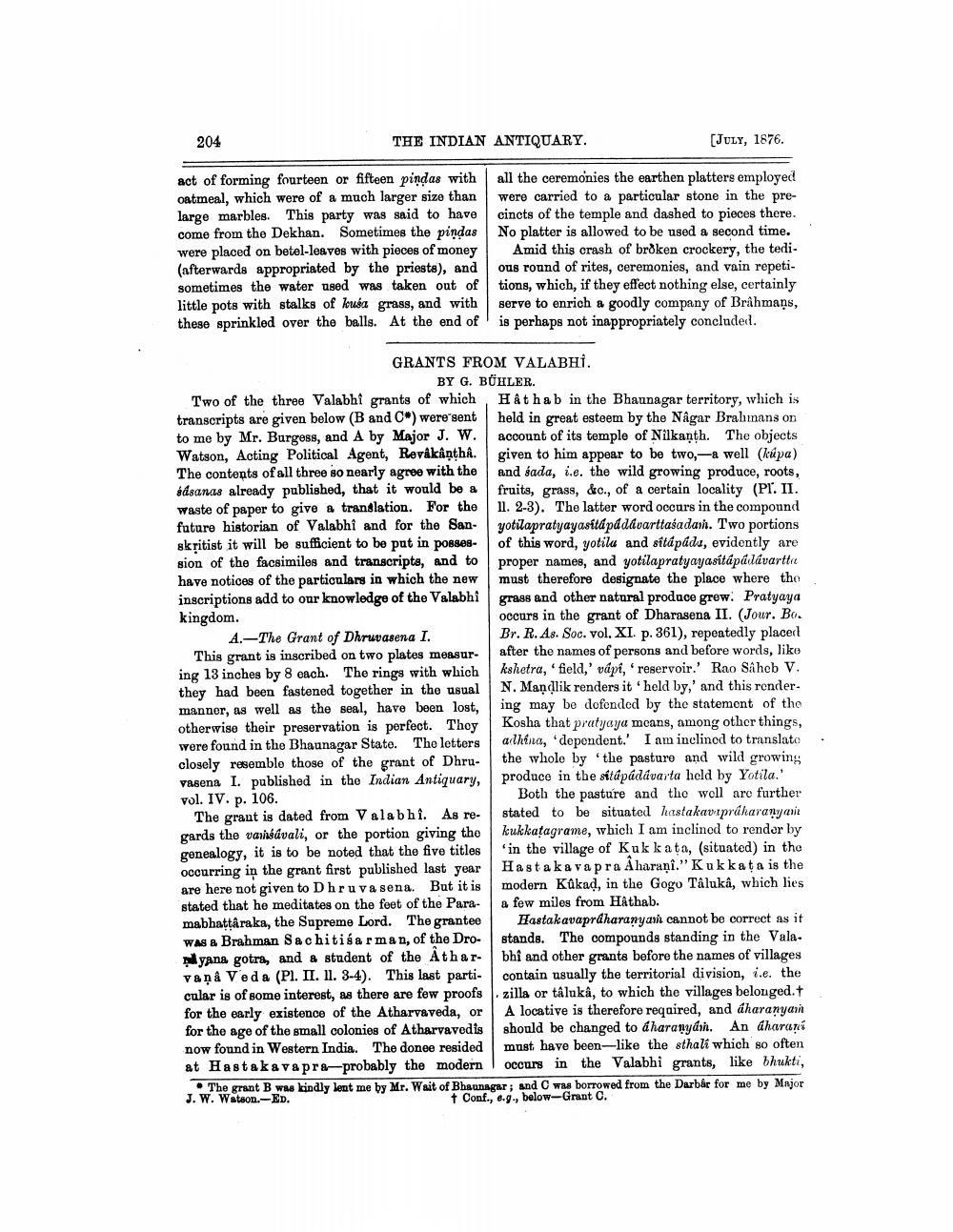________________
204
THE INDIAN ANTIQUARY.
(JULY, 1876.
act of forming fourteen or fifteen pindas with all the ceremonies the earthen platters employed oatmeal, which were of a much larger size than were carried to a particular stone in the prelarge marbles. This party was said to have cincts of the temple and dashed to pieces there. come from the Dekhan. Sometimes the pindas No platter is allowed to be used a second time. were placed on botel-leaves with pieces of money Amid this crash of brðken crockery, the tedi(afterwards appropriated by the prieste), and ous round of rites, ceremonies, and vain repetisometimes the water used was taken out of tions, which, if they effect nothing else, certainly little pots with stalks of kusa grass, and with serve to enrich a goodly company of Brahmans, these sprinkled over the balls. At the end of' is perhaps not inappropriately concluded.
GRANTS FROM VALABHI.
BY G. BÜHLER. Two of the three Valabhi grants of which H At hab in the Bhaunagar territory, which is transcripts are given below (B and C*) were'sent held in great esteem by the Någar Brahınans on to me by Mr. Burgess, and A by Major J. W. account of its temple of Nilkanth. The objects Watson, Acting Political Agent, Revakantha. given to him appear to be two, a well (kúpa) The contents of all three so nearly agree with the and bada, i.e. the wild growing produce, roots, ódsanas already published, that it would be a fruits, grass, &c., of a certain locality (PI. II. waste of paper to give a translation. For the 11. 2-3). The latter word occurs in the compound future historian of Valabhi and for the San- yotilapratyayasítápdddvarttasadan. Two portions skritist it will be sufficient to be put in posses- of this word, yotilu and sítápáds, evidently are sion of the facsimiles and transcripts, and to proper names, and yotilapratyayasítápadávartti have notices of the particulars in which the new must therefore designate the place where the inscriptions add to our knowledge of the Valabhi grass and other natural produce grew. Pratyaya kingdom.
occurs in the grant of Dharasena II. (Jour. Bo. A.-The Grant of Dhruvasena I.
Br. R. As. Soc. vol. XI. p. 361), repeatedly placed This grant is inscribed on two plates measur. after the names of persons and before words, like ing 13 inches by 8 each. The rings with which kshetra, 'field,' vápi, reservoir.' Rao Saheb V. they had been fastened together in the usual N. Mandlik renders it held by,' and this ronder. manner, as well as the seal, have been lost, ing may be defended by the statement of the otherwise their preservation is perfect. Thoy Kosha that pratyaya means, among other things, were found in the Bhaunagar Stato. The letters alhina, dependent.' I am inclined to translato closely resemblo those of the grant of Dhru- the whole by the pasture and wild growing vasena I. published in the Indian Antiquary, produce in the sitápádávarta held by Yotila.' vol. IV. p. 106.
Both the pasture and the well aro further The grant is dated from Valabhi. As re- stated to be situated hastakav praharanyarit gards the vann dvali, or the portion giving the kukkatagrame, which I am inclined to render by genealogy, it is to be noted that the five titles in the village of Kuk kata, (situated) in the occurring in the grant first published last year Hasta ka vapra Aharani." Kukkata is the are here not given to Dhruva sena. But it is modern Kükad, in the Gogo Taluka, which lies stated that he meditates on the feet of the Para- a few miles from Hâthab. mabhattâraka, the Supreme Lord. The grantee Hastakavapriharanyai cannot be correct as it WAS a Brahman Sachitisarman, of the Dro- stands. The compounds standing in the Vala
yana gotra, and a student of the Athar- bhi and other grants before the names of villages vaņå Veda (Pl. II. 11. 3-4). This last parti- | contain usually the territorial division, i.e. the cular is of some interest, as there are few proofs . zilla or tâluka, to which the villages belonged. for the early existence of the Atharvaveda, or | A locative is therefore required, and dharanyai for the age of the small colonies of Atharvavedis should be changed to kharanyám. An dharani now found in Western India. The donee resided must have been-like the sthali which so often at Hastaka vapra-probably the modern occurs in the Valabhi grants, like bhukti,
The grant B was kindly lent me by Mr. Wait of Bhaunagar; and C was borrowed from the Darbar for me by Major J. W. Wstaon.-ED.
t Conf., 6.9., below-Grant C.




